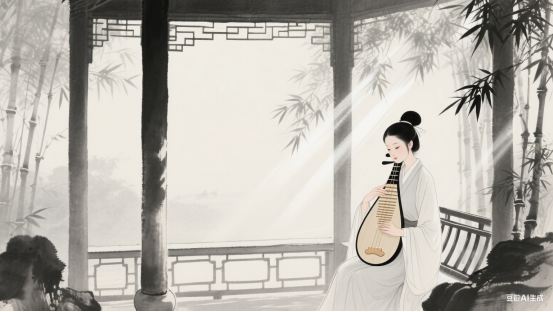
The pipa is a well-known Chinese musical instrument. Its name comes from the two main playing techniques: “Pi” and “Pa”. The instrument gained this name during the Sui and Tang Dynasties, while its physical form became fixed later, during the Ming and Qing Dynasties.
The Tang Dynasty marked a period of great popularity for the pipa. Frequent musical competitions during this time helped musicians develop and improve their playing skills significantly. This lively environment pushed pipa performance techniques forward.
Pipa music, passed down through history, falls into three main types. The first is the literary score, which aims to express deep feelings. This style features soft, smooth, and light music. Famous examples include The Moonlit Night on Spring River and The Imperial Palace Autumn Moon. The second type is the martial score. This style is strong and powerful, often describing exciting battle scenes. Key pieces in this style are Surrounded on All Sides and The Overlord Doffs His Armor. The third type, the big score, is known for being active and free in its expression.
Centuries of development have given the pipa a rich collection of music and highly developed playing methods. An important collection, the Huaqiuping Pipa Score, published in 1818, gathered more than ten complete pieces. Later, Shen Hao, part of the Pudong School tradition, wrote the Yangzhengxuan Pipa Score in 1929. This work recorded the special playing techniques of the Pudong School. The 20th century saw important contributions from musicians like Liu Tianhua and Hua Yanjun. Both were famous for playing the pipa and for writing new music for it, helping the instrument develop further.
Modern times continue this tradition of innovation. The well-known pipa player Liu Dehai composed a famous concerto called The Brave Sisters on the Grassland. This piece not only introduced new playing techniques but also explored fresh possibilities for pipa performance. The pipa’s long journey shows its lasting importance in Chinese music, constantly finding new ways to express beauty and emotion.
原创编写 版权所有 侵权必究! 每日更新 个性化阅读 英语飙升!
1.1. What helped the development of the pipa during the Tang Dynasty?
A Foreign influences.
B Royal ceremonies.
C Music contests.
D New materials.
解析:选C。C 细节理解题。原文第二段明确说明“Frequent musical competitions... pushed pipa performance techniques forward”(细节定位)。A(外来影响)、B(皇室仪式)、D(新材料)均未提及(属于无中生有)。故选C。
2.2. Which pipa style has great strength and power?
A Literary score.
B Classical score.
C Big score.
D Martial score.
解析:选D。 D 细节理解题。原文第三段定义“The second type is the martial score. This style is strong and powerful, often describing exciting battle scenes.”武曲风格刚劲有力。A文曲(soft and light)、C大曲(active and free)特征不符(属于张冠李戴),B古典曲是虚构概念(属于无中生有)。故选D。
3.3. Which work belongs to the Pudong School?
A Huaqiuping Pipa Score
B Imperial Palace Autumn Moon
C Yangzhengxuan Pipa Score
D Surrounded on All Sides
解析:选C。C 细节理解题。原文第四段指出沈浩作为浦东派传承人“wrote the Yangzhengxuan Pipa Score”(《养正轩琵琶谱》)。A《华秋苹琵琶谱》(1818年合集)、B《月儿高》(文曲代表作)、D《十面埋伏》(武曲)均属其他类别(属于张冠李戴)。故选C。
4.4. How does Liu Dehai bring new ideas to the pipa?
A By reviving ancient scores.
B By composing concertos.
C By simplifying techniques.
D By teaching students.
解析:选B。B 推理判断题。第五段提到刘德海创作了协奏曲《草原小姐妹》,且该作品“introduced new playing techniques”(引入新演奏技巧)、“explored fresh possibilities”(探索新的表演可能性),由此可推断,他通过创作协奏曲的方式为琵琶演奏带来新创意。故选B。
